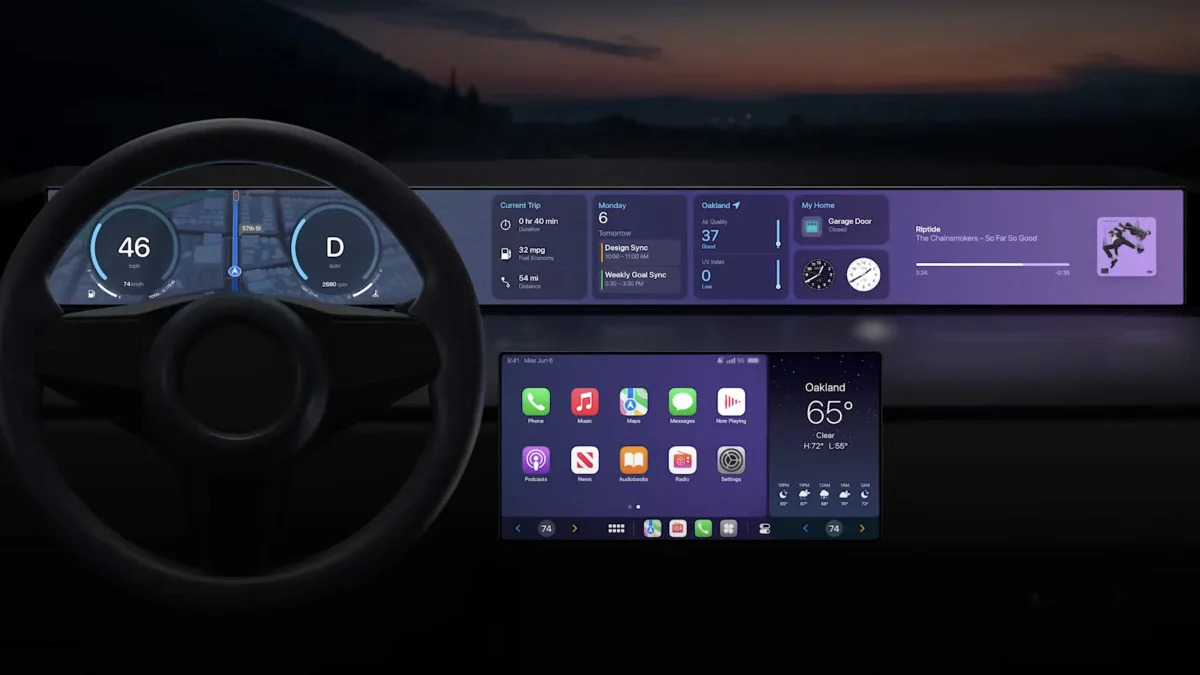A big gamble by General Motors (GM) is causing consternation for its dealers in the all-important race to sell cars — namely electric vehicles.
As the auto industry gears up for its big electric transition, GM’s move to phase out smartphone-like software like Apple (AAPL) CarPlay in its future EVs has some dealers puzzled. That’s because drivers really like to use Apple CarPlay when driving.
At Apple’s WWDC event last year, the company said CarPlay was available in an astounding 98% of new cars sold last year and that 79% of new car buyers would only consider purchasing a vehicle that’s CarPlay compatible. In addition, Consumer Reports found in a recent survey that 57% of respondents were “very satisfied” with CarPlay, compared to 50% satisfaction with the automaker’s built-in system.
GM says it will instead offer a new integrated infotainment system that leverages Google (GOOGL) built-in applications for cars (i.e., Maps, Assistant, PlayStore), in addition to apps such as Spotify (SPOT) and Audible (AMZN).
“Like most corporate decisions, this one is driven by revenue in the hyper-subscription world we now occupy. And like most hyper-subscription-driven decisions — I’m looking at you, BMW and Ford — this one will backfire.”
Nonetheless, GM’s dealers are very concerned. Several dealers told the Detroit Free Press that they're worried new buyers will seek out automakers that plan to offer CarPlay indefinitely.
“CarPlay’s not broken. Why fix it?” a source in close contact with multiple GM dealers told the paper. “The risk of failure is very high.”
GM says its new built-in infotainment system will debut in the 2024 Chevy Blazer EV, coming out later this year.
“If we're going to take that feature out of our vehicles, we need to respond with a program and a customer package that is equally as compelling, if not more compelling,” GM CFO Paul Jacobson said to Yahoo Finance earlier this year. “We think with the partnership we have with Google, and ultimately with the vehicle data we have, we can create an experience that customers are going to love."
Longtime industry analyst Karl Brauer of iseecars.com understands why GM made the decision to drop CarPlay, but said the move could be a costly one.
“Like most corporate decisions, this one is driven by revenue in the hyper-subscription world we now occupy. And like most hyper-subscription-driven decisions — I’m looking at you, BMW and Ford — this one will backfire,” Brauer told Yahoo Finance. “GM’s position is that its Google-based system is better than Apple CarPlay. If true, they can continue to offer both CarPlay and the Google system with full confidence consumers will choose the Google system … right?”
It seems GM isn’t going to offer all three systems and see which one the user prefers, to the chagrin of prospective GM buyers and dealers. And this is likely because of the bottom line.
GM is aiming to collect more of its own data to not only better understand drivers, but also to pad its longer-term profit margins. GM told investors this spring it's looking to achieve profit margins of more than 20% on "new businesses" by 2030, which presumably include services like its infotainment system that it could charge fees for add-on features.
This isn’t anything new in the auto industry — Tesla has been offering subscription services for years now. Call it the "Netflix Effect," and most automakers are looking to get in on the game too. GM’s crosstown rival Ford is looking to build a “software-defined vehicle” that can be updated over the air with ease while having the ability to charge users for add-on features.
But the big difference here is Ford CEO Jim Farley won’t get rid of CarPlay. “70% of our Ford customers in the U.S. are Apple customers. Why would I go to an Apple customer and say, ‘Good luck’?” Farley said earlier this year. “That doesn’t seem very customer-centric, and Apple does a really good job.”
However, companies that do chase revenue streams like subscription fees will need to prove that their offerings are a customer value-add, or at least as Farley puts it, be customer-centric.
“When consumers can’t immediately see the value in a subscription fee, such as charging for things that used to be free — like BMW charging for CarPlay — or simply charging too much — like Ford cranking the price of BlueCruse — consumers react,” iseecar.com’s Brauer said. “And the reaction doesn’t reflect well on the company, often driving customers away.”
Pras Subramanian is a reporter for Yahoo Finance. You can follow him on Twitter and on Instagram.
Click here for the latest stock market news and in-depth analysis, including events that move stocks
Read the latest financial and business news from Yahoo Finance










Sign in to post
Please sign in to leave a comment.
Continue